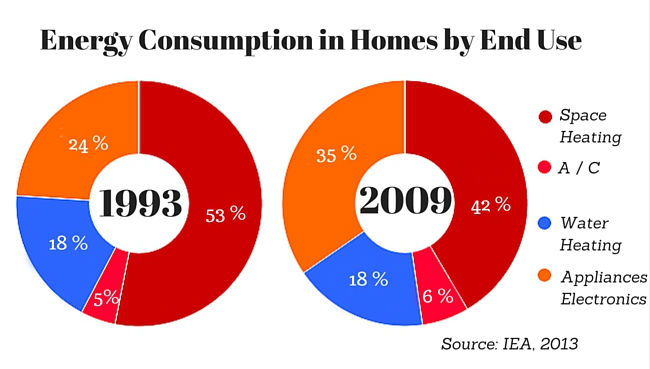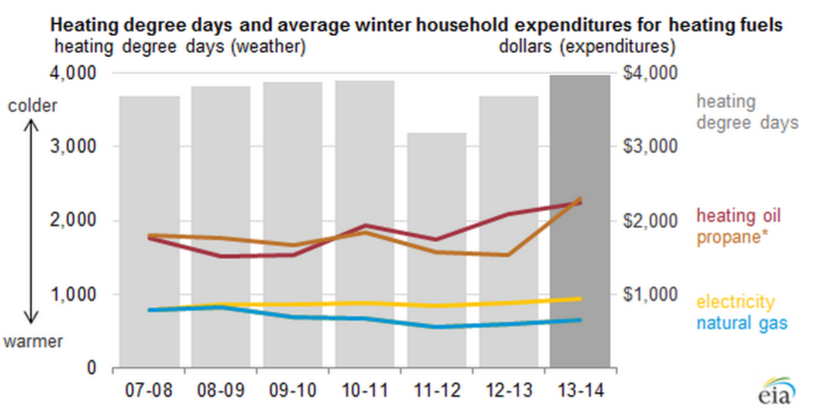Average US Household Energy Consumption - How Do You Compare?
According to the US Energy Information Administration, the average US household in 2013 used about 10,900 kilowatt-hours annually, or just over 900 kWh per month. However, consumption and price vary greatly across the United States, with Louisiana having the highest average annual consumption (15,270 kWh) and Hawaii the lowest (6,176 kWh).
- Keep in mind, your energy consumption can vary depending on
- Your geographic location
- What type of heating and cooking appliances you use
- How many people live in your home
- Your personal habits
What uses the most energy at home?
In general, most energy that Americans use goes towards space and water heating. However, as you can see below, this is changing slightly; as homes are becoming more efficient (better insulation, more efficient equipment and windows), less energy is being used for heating/cooling. Instead, energy consumption for appliances and electronics is rising.

In fact, according to the US EIA, electricity use in households is rising steadily, largely because of our increased use of electronics and other electricity-powered devices. For example, whereas in 1993 only 22% of households had three or more televisions and less than 45% used central air-conditioning, in 2009 nearly half of all homes contain three or more televisions, and more than 60% use central air-conditioning.
How Much Does the Average US Home Spend on Energy?
Energy costs can vary depending on what type of fuel you use for space heating/cooling, the efficiency of your home, how many people live in your home, etc. Some homes use electric heating, while others use natural gas fueled a furnaces or boilers to distribute hot air or water to ducts and radiators throughout the house, and a small percentage of homes (mainly conentrated in the Northeast) use heating oil. While some newer homes might feature "on demand" water heating, most traditional homes still use a natural gas boiler to provide hot water to sinks and showers and/or bathtubs. In warmer regions, air conditioning systems might replace heating as the primary energy expense.
Average monthly electric bills by US region
| Region | $ per month. |
|---|---|
| New England | 105.09. |
| Middle Atlantic | 110.88 |
| East North Central | 96.77 |
| West North Central | 106.03 |
| South Atlantic | 123.93 |
| East South Central | 125.91 |
| West South Central | 126.75 |
| Mountain | 99.15 |
| Pacific Contiguous | 90.84 |
| Pacific Noncontiguous | 160.32 |
Natural Gas

An increase in the share of households who do not use natural gas to heat their homes has meant that natural gas consumption has been declining in the US, falling 22% from 1990 to 2009. Increased efficiency in homes built after 1990, which consume 25% less natural gas than pre-1990 homes, has also contributed to this decline. Households in the Midwest are most likely to use natural gas as their primary heating fuel, followed by the West, Northeast, and South.
- Midwest - 71.9% of households
- West - 60.7% of households
- Northeast - 55.3% of households
- South - 33.4% of households
How to lower your energy bills
There are a few things that you can do to increase efficiency, and ultimately pay less every month for gas and electricity.
- Shop for a better rate: depending on where you live, you may have a choice of energy provider. Alternate energy suppliers can provide you with a greater range of price options and many offer lower rates than what you find with your utility
- Smart thermostats - Most thermostats can be programmed to turn the heat down or off at certain times of the day. However, smart thermostats like the popular Nest can go even beyond this, learning about your habits, and adjusting themselves to save energy when you are gone, and then anticipating your return home. Often they can be controlled via smartphone applications as well.
- Keep your vents clean and open - When dust builds up on the filter inside your vents (if you have forced-air heating via a furnace), it can block the flow of hot air, both wasting energy, and causing your furnace to run longer than necessary to eventually heat the room to the set temperature.
- Weatherize your home - Home weatherization can save you money by stopping air drafts and keeping more heat in your home.
- Control airflow - If you run ceiling fans, make sure they are spinning the right way! When it is hot, the fans should spin counter-clockwise to push air towards the ceiling, and eventually out of the house. When it is cold, fans should spin clockwise to redirect hot air downwards.
- Adjusting laundry habits - washing clothes in cold water and air drying instead of using the dryer can save a lot of money in energy costs. So can only doing laundry at full load, and - if you pay different rates for your electricity based on the time of use - after 8:00 PM, when electricity prices are lower.
- Making sure your home is well insulated - This can be a bigger and more expensive project, but if you engage in a home addition, or a renovation of some part of your home, spending more now on higher quality insulation can save you a lot of money in the future in reduced heating/cooling costs.
Find Out More Check out some of our energy saving tips in general and in the summer